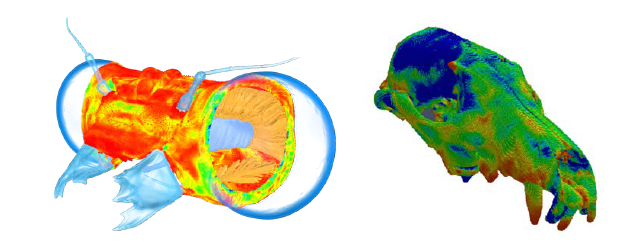VOX-FE for biomechanical modelling - new functionality for new communities
eCSE04-11Key Personnel
PI/Co-I: Prof Michael Fagan - University of Hull; Mr Iain Bethune - EPCC, University of Edinburgh
Technical: Dr Richard Holbrey - University of Hull; Dr Neelofer Banglawala - EPCC, University of Edinburgh
Relevant Documents
eCSE Technical Report: VOX-FE - new functionality for new communities
Project summary
Biological structures, such as bones, have complex geometries and variable material properties, and experience complex and varying applied loads, for example from muscular activity. To understand the true biomechanical performance of these structures is therefore challenging. Experimental measurements can be extremely difficult, are usually not possible in humans, and are ethically undesirable in animals. Computational modelling is an alternative approach with many advantages over experimental methods.
VOX-FE is voxel-based finite element software specifically developed for the analysis of very large-scale, high-resolution models of complex biological structures. Voxel based modelling allows us to go directly from microCT scan data to finite element models with minimal loss of data and geometry simplifications, thereby capturing all the complex internal and external features. It also allows inclusion of local variation in material properties based on voxel grey scale value. It is these microscopic-level geometry and material property variations that explain much of the complex macroscopic behaviour of bone.
In this project the capabilities of VOX-FE have been extended to allow the analysis of such very high resolution models (up to 200M elements); c.f. commercial finite element software which is typically limited to models with less than 10 million elements. That dramatic increase in capability required the implementation of a new HPC solver with smart partitioning of the mesh to improve solution performance. Voxel-level specification of material properties was also implemented allowing the smooth variation of material properties throughout the model, based on grey scale value.
In addition to these improvements in basic model definition, a muscle wrapping capability has been added to allow any shape or size of muscle attachment to be defined on the model and for the forces created by the wrapping contact of the muscles to be included automatically in the model file.
Finally, an adaptive remodelling facility has been added to VOX-FE. This allows the model to react and iteratively adapt to the stresses and strains that it experiences in the same way that bone is continually adapting in the body.
Overall these new developments provide a significant improvement in the capabilities of VOX-FE, allowing more accurate geometry, material property and loading definitions, whilst also offering adaptive remodelling possibilities. The number of potential applications and opportunities for VOX-FE is enormous. These include: high resolution modelling of whole bones to understand normal and pathological bone biomechanics, for conditions such as osteoporosis and Perthes' disease; growth and development of bones; and in silico design and testing of new dental and orthopaedic implants. The software will also be of use in predictive biology and virtual experimentation to reduce animal experiments, and in understanding the biomechanics of living and extinct animals in general, from insects to dinosaurs.

Voxel-based finite element analysis of a dragonfly head capsule (width 2mm) and a red fox skull (length 150mm). (Red = high strain, blue = low strain).
Summary of the software
The VOX-FE home page and SVN repository can be found at:
http://vox-fe.sourceforge.net
VOX-FE is free software under the terms of the BSD license.
In May 2015 we released VOX-FE 2.0 (shortly followed by 2.0.1, containing a bug fix) via SourceForge. This version contained the functionality implemented during the preceding eCSE project - the VOX-FE GUI plugin for ParaView and the new solver based on PETSc. This version is also installed on ARCHER, and can be accessed by all users by loading the module voxfe/2.0.1.
The new developments from this project will be made available in a 3.0 release, pending the resolution of a bug relating to the ordering of the final output from the solver. At present, all of the code developed in this project is available in the public SVN.






